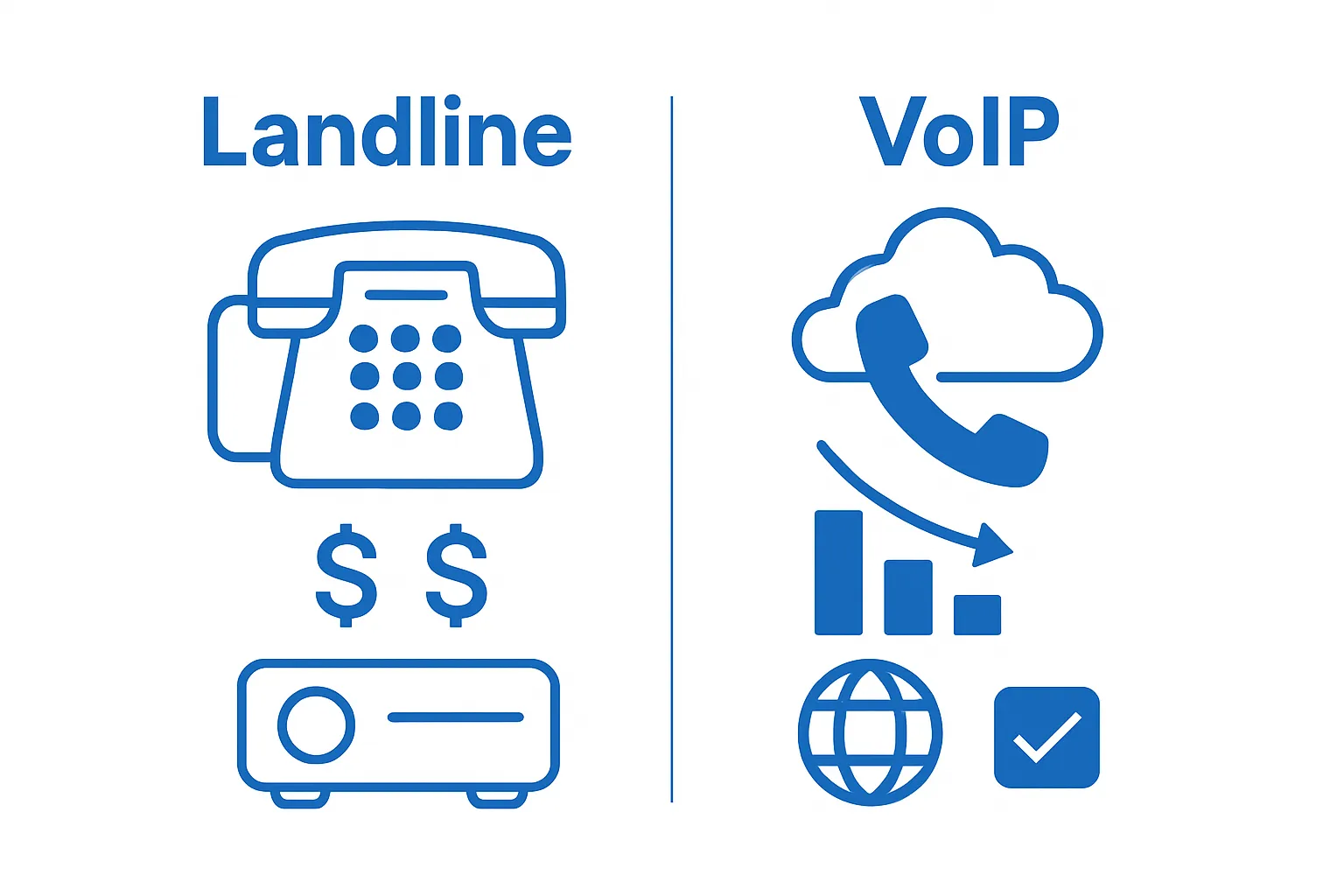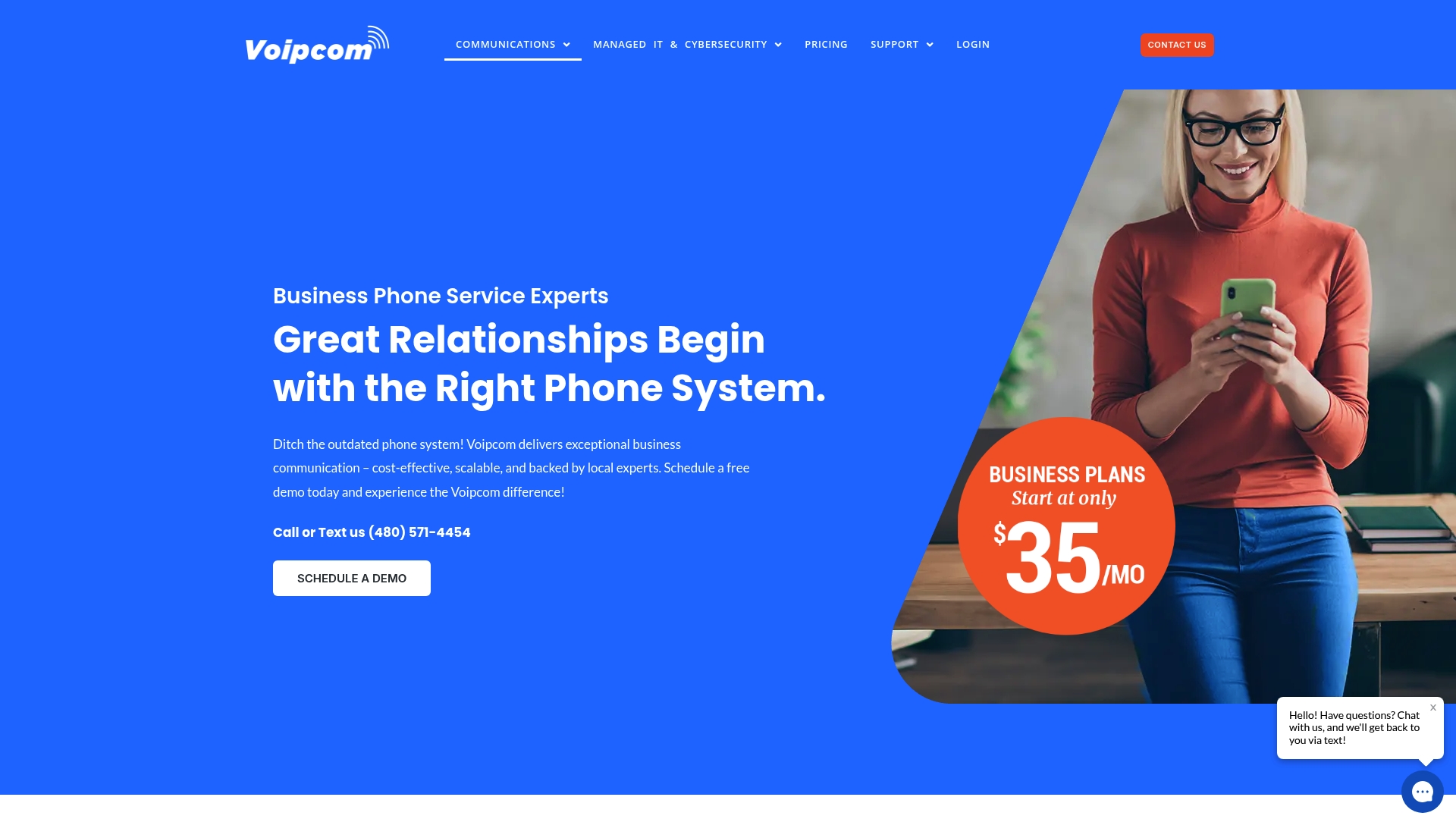VoIP is changing how people talk to each other every day and the numbers prove it. Over 200 million businesses worldwide are already using VoIP for their calls and meetings. Most folks assume this is just about making cheaper international calls or ditching old phone lines. Actually the real breakthrough is in what VoIP lets companies do behind the scenes. Suddenly any business can run video calls, chat, and share documents all from one place. That flips the script for communication at work.
Table of Contents
- What Is VoIP And How Does It Function?
- Why VoIP Matters For Business Efficiency
- Key Benefits Of VoIP For Small And Medium-Sized Businesses
- VoIP Applications In Different Industries
- Understanding Security And Compliance In VoIP Usage
Quick Summary
| Takeaway | Explanation |
|---|---|
| VoIP reduces communication costs significantly | Utilizing existing internet connections lowers long-distance rates and hardware expenses, making it a cost-effective option. |
| Scalability is a key advantage of VoIP | Businesses can easily add or remove lines without heavy infrastructure investments, allowing for rapid growth. |
| VoIP enhances productivity through integration | Advanced features like video conferencing and messaging tools improve collaboration and connectivity for remote teams. |
| Security measures are essential for VoIP systems | Robust security strategies, including encryption and multi-factor authentication, protect sensitive communications from threats. |
| Compliance with regulations is critical | Organizations must adhere to industry-specific standards, such as HIPAA or PCI DSS, to ensure secure communications. |
What is VoIP and How Does It Function?
Voice over Internet Protocol (VoIP) represents a transformative communication technology that enables voice communications through internet connections instead of traditional telephone networks. Voice communication technology fundamentally changes how businesses and individuals communicate by converting analog voice signals into digital data packets.
Understanding VoIP Technology
At its core, VoIP works by breaking down voice conversations into digital data that can be transmitted across internet networks. Unlike traditional phone systems that require dedicated copper wire infrastructure, VoIP leverages existing internet connections to transmit voice communications. This process involves several critical steps:
The table below highlights the main components of VoIP technology and provides clear explanations for each, helping readers understand their role in business communications.
| Component | Description |
|---|---|
| Codecs | Software that compresses and decompresses voice data, enabling efficient transmission |
| IP Phones | Specialized phones designed to work directly with internet protocols |
| Routing Protocols | Systems responsible for directing digital voice packets across the network infrastructure |
-
Converting analog voice signals into digital data packets
-
Routing these packets through internet protocols
-
Reassembling digital packets into coherent audio at the receiving end
Key Technical Components of VoIP:
- Codecs: Software that compresses and decompresses voice data for efficient transmission
- IP Phones: Specialized telephones designed to work directly with internet protocols
- Routing Protocols: Systems that direct voice packets across network infrastructure
Business Communication Transformation
For businesses, VoIP represents more than just a communication method. Our guide on business communication solutions demonstrates how this technology provides significant advantages over traditional phone systems. By utilizing internet infrastructure, organizations can reduce communication costs, increase flexibility, and integrate advanced features like video conferencing, instant messaging, and unified communications platforms.
The technological breakthrough of VoIP lies in its ability to treat voice as just another form of data, enabling more versatile and cost-effective communication strategies for modern businesses. This digital transformation allows companies to scale communication infrastructure more efficiently, support remote work environments, and implement sophisticated communication workflows with minimal physical infrastructure requirements.
Why VoIP Matters for Business Efficiency
Business communication technologies are constantly evolving, and VoIP stands at the forefront of this transformation. Government research on communication infrastructure highlights how VoIP systems can dramatically improve organizational efficiency by streamlining communication processes and reducing operational costs.
Cost Reduction and Financial Benefits
Traditional phone systems require significant investments in hardware, maintenance, and dedicated infrastructure. VoIP eliminates many of these expenses by utilizing existing internet connections. Financial advantages include:
- Reduced long-distance and international calling rates
- Lower hardware and maintenance costs
- Simplified telecommunications infrastructure
- Predictable monthly communication expenses
Operational Cost Savings:
- Elimination of separate voice and data network infrastructures
- Minimal physical hardware requirements
- Scalable solutions that grow with business needs
Enhanced Productivity and Flexibility
Voice Over IP systems can help small businesses grow by providing robust communication tools that support modern work environments. Remote teams, distributed workforce models, and flexible communication strategies become significantly more manageable with VoIP technology.
The ability to integrate communication channels seamlessly transforms how businesses operate. Employees can access voice, video, and messaging platforms from multiple devices, ensuring continuous connectivity and improved collaboration. This technological approach supports dynamic work environments where traditional phone systems would create substantial limitations.
The following table compares traditional phone systems with VoIP technology to help illustrate key differences and benefits for businesses considering the switch.
| Aspect | Traditional Phone System | VoIP Technology |
|---|---|---|
| Infrastructure Requirement | Dedicated copper wiring | Utilizes existing internet connections |
| Scalability | Requires hardware upgrades for additional lines | Easily add or remove lines |
| Upfront Costs | High (hardware and installation) | Low (minimal physical equipment) |
| Monthly Costs | Higher due to maintenance and call charges | Lower with predictable monthly expenses |
| Advanced Features | Limited (mainly voice calls) | Video conferencing, messaging, call analytics, integrations |
Ultimately, VoIP is not just a communication tool but a strategic business asset that enables organizations to communicate more effectively, reduce expenses, and adapt quickly to changing technological landscapes.
Key Benefits of VoIP for Small and Medium-Sized Businesses
Small and medium-sized businesses face unique communication challenges that require flexible, cost-effective solutions. State legislature research on telecommunications demonstrates how VoIP provides transformative advantages for organizations seeking efficient communication strategies.
Scalability and Adaptability
Unlike traditional phone systems that require complex hardware investments, VoIP enables businesses to scale communication infrastructure rapidly. Scalability benefits include:
- Easy addition or removal of phone lines
- Minimal upfront capital expenditure
- Quick adaptation to changing business needs
- Support for remote and distributed workforce models
Flexible Configuration Options:
- Customizable call routing
- Virtual receptionist capabilities
- Integration with existing business software
- Seamless mobile and desktop application support
Advanced Communication Features
Discover top VoIP features for small businesses that go beyond traditional communication tools. Modern VoIP systems offer comprehensive communication ecosystems that empower businesses to communicate more effectively and professionally.
These advanced features include video conferencing, instant messaging, call recording, and sophisticated analytics that provide insights into communication patterns. Small businesses can leverage these tools to compete with larger organizations, creating a more agile and responsive communication infrastructure.
By embracing VoIP technology, small and medium-sized businesses can transform their communication strategies, reduce operational costs, and create more dynamic, interconnected work environments that support growth and innovation.
VoIP Applications in Different Industries
VoIP technology has revolutionized communication strategies across diverse business sectors, offering tailored solutions that address unique industry challenges. Healthcare communication research demonstrates the profound impact of adaptable communication technologies in specialized professional environments.
Healthcare and Medical Services
Healthcare organizations leverage VoIP to enhance patient communication, streamline administrative processes, and maintain critical privacy standards. Key applications include:
- HIPAA-compliant communication platforms
- Secure patient appointment scheduling
- Integrated telehealth consultation systems
- Advanced call routing for emergency medical services
Critical Communication Features:
- Multi-device accessibility
- Encrypted voice transmission
- Call recording and documentation
- Seamless integration with electronic health records
Professional Services and Remote Collaboration
Explore unified communication strategies that transform how professional service firms operate. Law firms, consulting agencies, and financial services organizations utilize VoIP to create sophisticated communication ecosystems that transcend geographical limitations.
VoIP enables these industries to maintain professional communication standards while supporting distributed workforce models. Features like video conferencing, instant messaging, and advanced call management provide unprecedented flexibility for teams working across different locations.
By adopting VoIP technologies, industries can dramatically improve communication efficiency, reduce operational costs, and create more responsive, interconnected professional environments that adapt quickly to changing business landscapes.
Understanding Security and Compliance in VoIP Usage
As businesses increasingly adopt VoIP technologies, understanding comprehensive security and compliance protocols becomes crucial. National Institute of Standards security guidelines highlight the critical importance of implementing robust protection mechanisms for digital communication systems.
Cybersecurity Challenges in VoIP
VoIP systems present unique security vulnerabilities that differentiate them from traditional communication infrastructures. Potential risks include:
- Potential eavesdropping on digital communication channels
- Vulnerability to denial-of-service attacks
- Risk of unauthorized system access
- Potential interception of voice data packets
Key Security Mitigation Strategies:
- Implementing end-to-end encryption
- Utilizing multi-factor authentication
- Regular security audits and vulnerability assessments
- Maintaining updated network security protocols
Regulatory Compliance and Industry Standards
Learn about critical cybersecurity prevention strategies that help organizations maintain rigorous communication security standards. Different industries require specific compliance frameworks that dictate communication security requirements.
Healthcare organizations must adhere to HIPAA regulations, financial institutions require PCI DSS compliance, and government contractors need to meet stringent federal communication security standards. These regulatory requirements demand sophisticated VoIP security approaches that protect sensitive information while maintaining communication efficiency.
Successful VoIP security goes beyond technical implementations. It requires a holistic approach that combines technological safeguards, employee training, continuous monitoring, and adaptive security strategies that evolve with emerging digital communication threats.
This table summarizes key security challenges in VoIP systems and corresponding mitigation strategies, giving readers a quick reference to essential protections.
| Security Challenge | Description | Mitigation Strategy |
|---|---|---|
| Eavesdropping | Unauthorized interception of voice data packets | Implement end-to-end encryption |
| Denial-of-Service (DoS) | Attacks that disrupt communication services | Maintain updated security protocols |
| Unauthorized Access | Unapproved entry into communication systems | Use multi-factor authentication |
| Vulnerability to Exploits | Risks associated with unpatched systems | Conduct regular security audits |
Ready to Transform Your Business Communication?
Traditional phone systems drain your budget and hold back productivity. As discussed in our article, solutions like VoIP take away those barriers by converting voice into digital data, letting you communicate seamlessly from anywhere. If you are struggling with high communication costs, limited flexibility, or complex system management, it is time to consider switching to a modern platform.
Join the businesses already enjoying secure, cloud-based communication with Voipcom. Discover how our cloud business phone solutions can help you migrate from outdated phone setups, unlock powerful features like AI-enhanced calling, and simplify your IT support. Do not wait while your competition moves forward. Visit Voipcom now to start streamlining all your communications and empower your workforce today.
Frequently Asked Questions
What is VoIP and how does it work?
Voice over Internet Protocol (VoIP) converts analog voice signals into digital data packets and transmits them over the internet. This technology allows voice communications without traditional telephone networks, enhancing flexibility and reducing costs.
What are the key benefits of using VoIP for businesses?
VoIP offers several advantages for businesses, including reduced operational costs, flexibility in communication, scalability of the system, and advanced features like video conferencing and instant messaging that enhance productivity.
How does VoIP improve business communication efficiency?
VoIP streamlines communication processes by integrating various channels into one platform, enabling remote work, enhancing collaboration, and reducing communication costs compared to traditional phone systems.
What security measures should businesses implement for VoIP systems?
Businesses should implement end-to-end encryption, multi-factor authentication, regular security audits, and maintain updated security protocols to protect VoIP systems from potential vulnerabilities such as eavesdropping and unauthorized access.





